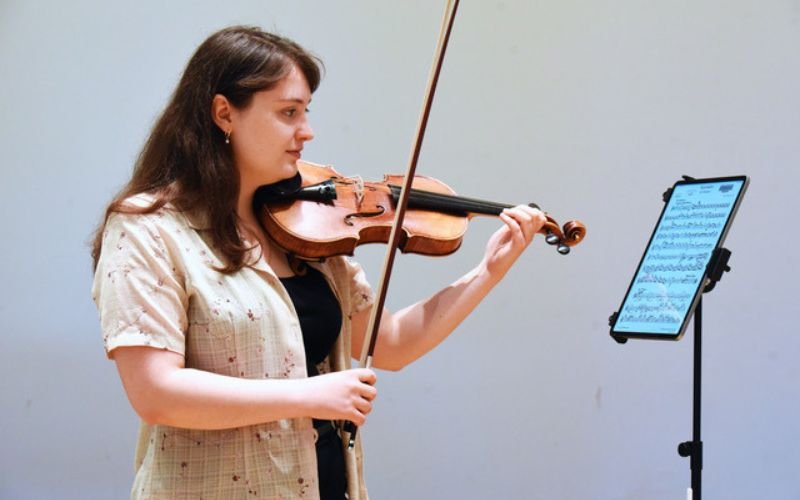All you need to know about different musical genres
Do you play a musical instrument but can't decide which musical style interests or suits you best? Soul, jazz, rock, electro, pop or rap: are you lost in the great diversity of genres that exist? It's normal: there are at least as many musical styles as there are ways of playing or composing music. If the Encyclopaedias are anything to go by, there are some 700 musical genres in the world.
Among these hundreds of genres and sub-genres, we can nevertheless highlight a dozen or so broad categories in which we find the main popular music styles. Newzik has sorted them out to help you find your way through this jungle of musical categories. Discover the major families of musical styles here, along with tips on how to better understand them and identify with a genre!
What is a musical genre?
According to the Larousse definition, a musical style is "the set of characteristics peculiar to an era, a composer, a way of performing, a mode of instrumental playing or an aesthetic trend that distinguishes them from others". In other words, a style is a set of musical elements that can be used to classify a work in a particular category.
A musical style is therefore part of a very specific period and culture, which makes it possible to classify it according to its era. Each musical genre has its own unique style, which can be defined by particular cultural codes and traditions. And, whatever the musical genre, it is characterized by a number of similar attributes that enable it to be identified, such as :
rhythmics,
the instruments used,
harmonies.
How do you identify a style or genre in music?
It's all very well to know what a musical genre is, but you still need to know exactly the right codes to identify it correctly. There are several characteristic elements to study:
rythm and rhythmic structure: some genres, such as jazz or electronic music, have highly distinctive rhythms.
Instrumentation: each genre has its own preferred instruments. For example, the electric guitar is emblematic of rock, while the saxophone is inseparable from jazz.
Harmonies and melodies: chord progressions and melodies can indicate a genre. Blues, for example, often follows a twelve-chord progression bars that loops through to the end of the piece and contains three chords.
Cultural context: some genres are deeply rooted in specific cultural contexts, such as reggae, which is linked to Jamaican culture.
Identifying a musical genre can require active listening and a certain familiarity with different musical styles. To do this, the best technique is to take the time to listen to different styles, and quietly deconstruct them to understand the characteristics that distinguish them.
Active listening and musical ear training can be a good way of improving your reflexes for recognizing musical styles. In particular, strengthening your harmonic ear can help you better perceive and understand chord progressions and harmonic relationships within a piece of music.
What are the main families of musical genres?
Among the hundreds of musical categories in existence, here's a list of ten major popular styles recognizable for their rhythmic and technical characteristics!
1. Classical music
Dating back to the Middle Ages for its earliest variations, classical music is a benchmark genre. Does Mozart's Magic Flute ring a bell? Although it has evolved since the 18th century, the classical music genre remains highly codified. Classical music has evolved over the centuries, culminating in the Baroque style of the 17th and 18th centuries. The classical genre offers great harmonic richness through a variety of forms(symphonies, concertos, sonatas, operas).
Among the musical instruments most commonly used in orchestras are the piano, violin, harp, organ and all orchestral instruments (strings, woodwinds, brass, percussion).
A reference piece of classical music : Symphony No. 5 in C minor by Ludwig van Beethoven
2. The rock
Rock emerged in the USA in the 1950s, with sub-genres such as metal and punk music appearing in the 1970s.
How do you recognize rock music? This genre is characterized by powerful rhythms, saturated electric guitars and verse-chorus structures. Metal music features elements such as heavy guitar riffs and complex rhythms. In punk music, the musical rhythm favors fast tempos and often short, direct songs.
Since the end of the 20th century, rock has evolved into many new sub-genres: pop-rock, progressive rock and indie rock.
A rock reference : Led Zeppelin's Stairway to Heaven
3. The blues
The blues musical genre emerged in the American South in the late 19th century as a derivative of African-American work songs and spirituals.
Characterized by a specific chord progression, blues songs are often divided into 12 bars, expressive melodies, and recurring themes of sadness and struggle against the slave trade. The guitar is the leading blues instrument, often accompanied by the harmonica and piano.
By the mid-1940s, blues was influencing other styles such as gospel and then rhythm and blues. These new styles are characterized by slightly livelier melodies and grooves, expressing the joys or sufferings of everyday life.
A blues reference : The Thrill Is Gone by B.B. King
4. Jazz
Born at the beginning of the 20th century, jazz saw its first days in the heart of the United States, particularly in New Orleans. This musical genre is the result of a crossbreeding between the culture of the black American people, born of slavery, and European culture, as well as the music of brass bands, salons (piano) and church gospel singing.
Jazz is characterized by improvisation, swing, modal scales and complex harmonies. Typical jazz instruments? Saxophone, trumpet, piano, double bass and drums.
A jazz reference : Dave Brubeck's Take Five
5. The soul
Soul music emerged in the USA in the 1950s and 1960s. It is a fervent blend of gospel, rythm and blues, and jazz.
Soul music features powerful vocals, syncopated rhythms and instrumentation including bass, drums, guitar and brass. Soul songs often deal with love, suffering and joy. Today, soul music has joined forces with pop, and more modern ambassadors like Amy Winehouse have kept the style alive with a huge audience.
A soul reference: Respect by Aretha Franklin
6. Hip-hop
Part culture, part dance, part music, hip-hop was born in the 1970s in New York's African-American neighborhoods, particularly in the Bronx.
The hip-hop genre is characterized by its often electronic beats, bass loops and musical samples, with rapped lyrics . Rap and RnB are the major sub-categories of hip-hop music.
Today, driven by artists such as Beyoncé and Rihanna, RnB combines all the codes of hip-hop with soul and pop influences, featuring more melodic vocals.
A hip-hop reference track : Rapper's Delight by The Sugarhill Gang
7. Electronic music
Electronic music began to develop in the 1970s with pioneers like the band Kraftwerk, then exploded worldwide in the 1980s and 1990s.
This genre relies on the use of synthesizers, drum machines, sequencers and computers (notably through the practice of CAM) to create sounds often unreproducible by acoustic instruments. There are many sub-genres of electronic music, including techno, house, trance and drum and bass.
A benchmark piece of electronic music: Around the World by Daft Punk
8. Country music
Emerging in the United States in the 1920s, country music has its roots in folk music, Irish and Scottish ballads, and Western music from the North American prairies.
In country music, it's very common to use instruments such as the acoustic guitar, banjo, fiddle and pedal steel guitar. Rural life, love and nostalgia are recurrent themes in country music repertoires. While country music is particularly popular in the United States, where it originated, the genre is enjoyed by fans the world over.
A reference country song : Jolene by Dolly Parton
9. Folklore
Modern folk music emerged at the beginning of the 20th century, although it has its roots in much older musical traditions. The genre reached its apogee in the mid-60s, when folksong became more varied, with a rock and roll influence.
Folk music focuses on acoustic compositions, often simple and melodic, with poetic protest lyrics inspired by social themes and acoustic instruments such as the acoustic guitar, banjo, fiddle and harmonica. In the 2000s, artists such as Ben Harper and Bon Iver took over from folk icons Bob Dylan and Joan Baez.
A benchmark folk song: Bob Dylan's Blowin' in the Wind
10. Reggae
Reggae music is an integral part of the Rastafari (also known as "Rasta") social movement, a spiritual culture developed in Jamaica in the 1930s. The musical genre was born from the fusion of ska and rocksteady music in the late 1960s. Its leading exponent is Bob Marley, who democratized the genre worldwide.
Reggae can be recognized by its syncopated rhythms, predominant bass and often politically or spiritually engaged lyrics . Reggae is distinguished by its musical codes and instruments such as guitar, bass, drums and keyboards, often accompanied by brass instruments.
A reggae reference: No Woman, No Cry by Bob Marley and The Wailers
Our tips for finding your musical style
Once you've familiarized yourself with the wide range of musical styles, you can determine which one(s) you're most familiar with. A few tips and exercises can help you get to grips with your own personal musical universe.
Analyze your musical tastes
Are you a fan of violin and classical harmonies? Are you passionate about wild guitar solos, or do you love the jerky rhythms delivered by high electronic BPMs played on turntables?
You certainly have more serious preferences for certain musical styles. To confirm these preferences, prepare playlists by style and note the emotions that the selected tracks arouse in you. Try to understand why you prefer certain sounds or rhythms. This can guide you towards the genre that suits you best.
If you have very eclectic tastes, take advantage of this opportunity to enrich yourself with all the diversity offered by musical registers!
Choosing an instrument that matches your musical preferences
Your choice of instrument will influence your learning and immersion in a specific genre. Once you've identified your musical preferences, don't hesitate to choose an instrument that will allow you to explore these styles! For example, if you like blues or rock, an electric guitar might be a good choice. For jazz, piano or saxophone are the instruments of choice.
💡 Can't find what you're looking for among the best-known musical instruments? Explore rarer and more unusual instruments like the Kalimba, Didjeridoo or Chapman stick!
Take music lessons to better understand playing styles
Learning music and how to read chords opens the door to a greater understanding of musical techniques. Learning music theory can also be a good introduction to chord progressions and rhythm games. Taking music lessons with an experienced teacher is therefore an excellent way to deepen your knowledge of a particular musical style. A good teacher will not only be able to teach you the techniques specific to your instrument, but also explain the specifics of a musical genre, such as syncopated jazz rhythms or rock guitar riffs.
Getting started in music composition
Composing your own music allows you to make a musical style your own. By experimenting with different chords, rhythms and melodies, you develop a sound that's all your own, while remaining true to the characteristics of a genre. Composing also helps you better understand the structure and nuances of a style.
Have you discovered the musical color of your work? Are you starting to compose and record your music? Now's the time to organize your repertoire of compositions and recordings in a a dedicated library. Transcribe, annotate and organize your scores and recordings in a single application with Newzik !





